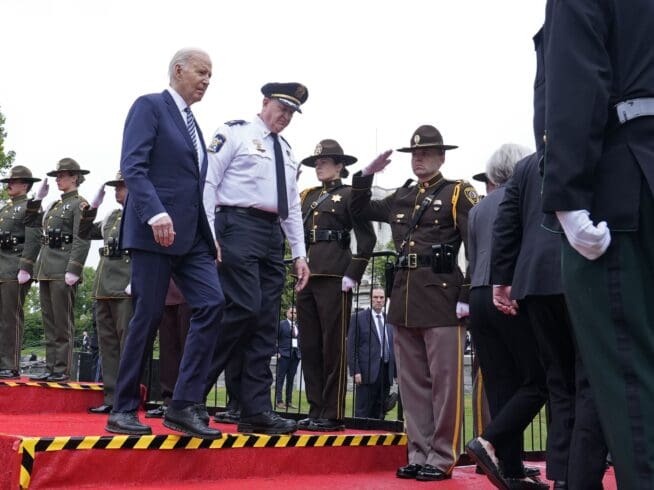Don’t be fooled by the Supreme Court’s code of ethics, advocates say
The Supreme Court’s new code of conduct and arguments on gun safety may appear to provide a glimmer of hope, but court watchers are skeptical.

The U.S. Supreme Court did two surprising things this November.
First, during oral arguments on Nov. 7, most of the court’s conservatives signaled they might support some restraint on the Second Amendment. The case before the court that day was United States v. Rahimi, examining whether a federal law that keeps guns out of the hands of domestic violence offenders is constitutional.
Next, on Nov. 13, the court announced it would be adopting a “code of conduct” for the first time in its 234-year history.
These developments come after years of criticism of the court’s recent lurch to the right, most prominently after conservatives won a six-seat court supermajority when Justice Amy Coney Barrett replaced the late liberal Justice Ruth Bader Ginsburg. The court in its current form has been described as among the most conservative in U.S. history.
The court is also now more unpopular than ever.
In September 2022, 59% of Americans agreed the Supreme Court was “out of touch,” according to a Monmouth University poll. They disagreed, though, on how to handle it. The same poll showed only 36% supported expanding the number of Supreme Court justices.
Public disapproval of the court’s rightward swing in cases like Dobbs v. Jackson Women’s Health Organization, which overturned the federal right to abortion, has been compounded by revelations about severe ethical questions surrounding some of the conservative justices’ behavior. Most notably, ProPublica reported in April on Justice Clarence Thomas’ acceptance of lavish, all-expenses-paid vacations, private school tuition for a nephew, and more from a conservative billionaire.
The court’s apparent intentions regarding the Second Amendment and its new code of conduct would seem to present two victories, then, for liberal and progressive critics of the court, who have criticized the court’s positions on gun safety and called for some sort of check on justices who behave like Thomas.
But not so fast, these critics say.
Just before the arguments in Rahimi, Shannon Watts, founder of Moms Demand Action for Gun Sense in America, expressed fear in an op-ed published on CNN’s website that the court would go out of its way to roll back gun safety laws even in the wake of a mass shooting in October in Lewiston, Maine, that left 18 dead.
“Yet, as our nation grieves the loss of so much life, the US Supreme Court could be poised to make it even easier for troubled people to access guns,” Watts wrote.
The prospect of another conservative ruling on guns, she said, was reason enough to continue pushing to expand and reform the Supreme Court. The court already issued what was seen as a drastic reinterpretation of gun safety rules in its ruling last year in New York State Rifle & Pistol Association, Inc. v. Bruen, which determined that any current law regulating guns be consistent with what the court construes to be the original intent of the Second Amendment.
“We need to channel the energy of gun safety advocates into fixing our broken Supreme Court,” Watts wrote. “We need Supreme Court expansion to restore balance and sanity to the Court. By passing a law to add more justices, we can give the president an opportunity to appoint four new justices who will help restore balance to the institution.”
Advocates say the possibility of a less reactionary ruling in Rahimi doesn’t indicate a true change in the current court’s trajectory.
Yet when the time came for oral arguments, the questions asked and statements made by the conservatives — apart from Samuel Alito and Clarence Thomas, the justices farthest to the right — suggested a possible decision that could be a far cry from the worst fears of the gun safety movement and a departure from Bruen.
“I think there would be little dispute that someone who was guilty, say, or even had a restraining order — that domestic violence is dangerous,” Justice Amy Coney Barrett said.
“You don’t have any doubt that your client’s a dangerous person, do you?” Chief Justice John Roberts asked the counsel for Zackey Rahimi, who was charged with unlawful possession of a firearm while subject to a restraining order that prohibited him from contacting his ex-girlfriend or her child and from owning guns.
“I understand your answer to say that there will be circumstances where someone could be shown to be sufficiently dangerous that the firearm can be taken from him,” Roberts said to Rahimi’s counsel at a later point.
“Yes,” the attorney, federal public defender James Matthew Wright, responded.
“And why isn’t that the end of the case?” Roberts asked.
“I will say Tuesday was a nice glimmer of hope — a tiny, tiny glimmer of hope for us,” Makennan McBryde, legal associate at gun violence prevention organization March For Our Lives, told the American Independent. “It was nice to see that, but I really do strongly hesitate to let one hopeful day of oral arguments signal the end of all of our problems at the historically unreined extremist conservative supermajority court.”
Many court-watchers had doubts about the code of conduct announcement as well.
“The Court has long had the equivalent of common law ethics rules,” the court’s nine justices say in their announcement of their new code. “The absence of a Code, however, has led in recent years to the misunderstanding that the Justices of this Court, unlike all other jurists in this country, regard themselves as unrestricted by any ethics rules. To dispel this misunderstanding, we are issuing this Code, which largely represents a codification of principles that we have long regarded as governing our conduct.”
Leah Litman, a law professor and co-host of the Supreme Court-focused podcast Strict Scrutiny, posted on the X platform, “The new SCOTUS ethics code: No real ethics, just vibes.”
She and many others pointed out that the code includes loopholes that allow justices to continue questionable activities, such as associating with overtly political legal organizations.
“Ex: the code specifically allows the justices to participate in fundraising for law related nonprofits. What is this, a hall pass for the Federalist Society galas and Koch Network 501c3 and 501c4 orgs?” Litman wrote. “This is to say nothing about how we don’t really know how this works or how it’s enforced — beyond the Justices own inclinations.”
Regardless of whatever positive steps the Supreme Court may appear to be taking, McBryde said, court expansion is something that needs to happen in order to rein in what has become a historically unpopular body.
“Court reform is inextricably linked to our ability to curtail gun violence,” she said. “Expanding the court tomorrow will have a direct effect on what Americans get to live and die next year, and the year after that.”
McBryde said Americans on the fence about court expansion should know that the number of justices was changed multiple times in the early history of the United States, and that expansion is an option the framers of the U.S. Constitution gave to Congress.
“It’s not just about the fact that we can expand and reform the court but that we really have to in the interest of curtailing gun violence,” McBryde said. “It has been that the will of the rich and the few is what brought us to the havoc in the courts, especially in the context of the Second Amendment.”




